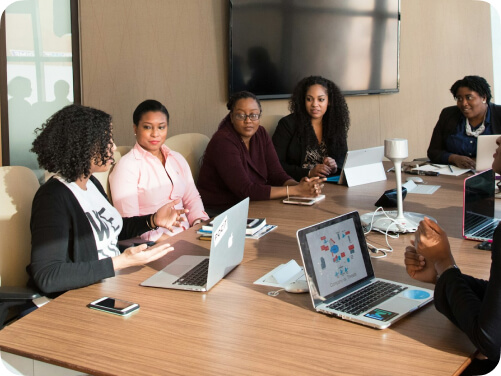Why training is key to building a more accessible and inclusive workplace

Creating an inclusive workplace isn’t just a trend - it’s essential. But here's the thing: inclusion doesn’t just happen because we want it to. It takes real work - targeted training that shifts mindsets, equips employees with the right tools, and ensures lasting change.
In a recent Hassell Inclusion webinar, experts talked about how effective training can break down the barriers to inclusion, and help build long-term accessibility skills across an organisation. They shared practical ways to design training that sticks, the kind that goes beyond ticking boxes and actually drives cultural change. In this blog, we’re diving into those insights and offering tips you can use to make your own training more impactful - just in time for our neurodiversity inclusion workshop next week.
Start with motivation: make it personal
Inclusion struggles when people care but don’t know how to act on it. That’s where training comes in. It’s not just about facts or checklists, it’s about making the issue feel personal. For example, activities like “speed dating” with people who have disabilities can help bring the experience to life. These kinds of interactions humanise the issue and make it real for people.
Training should also highlight the personal benefits of inclusion. Designers, developers, and other employees will see how accessibility helps them do their own jobs better. When people realise that improving accessibility helps them directly, they’re far more likely to take action.
Tailor training to fit your organisation
Not every organisation is built the same way, so training can’t be a one-size-fits-all approach. Whether your team is structured functionally, product-based, or project-based, accessibility training should be tailored to fit how your organisation operates.
In bigger companies, training everyone at once might not be realistic. If that’s the case, prioritise teams with the biggest impact, like marketing, design, and content. Tailoring training to the needs of specific departments or roles makes it more effective, and ensures you’re focusing your resources where they’ll make the most difference.
Training alone won’t cut it - it’s about long-term capability
Training is the starting point, but it’s not the finish line. To make a real, lasting difference in accessibility, training has to be part of a bigger, long-term strategy. This means combining training with other efforts like governance, inclusive design practices, and ongoing resources that help employees put their training into practice.
And don’t forget to regularly assess your team’s skills. Sometimes teams can feel overconfident about their knowledge, but accessibility practices evolve all the time. Regular check-ins and assessments help ensure everyone stays up-to-date on the latest best practices.
Make accessibility part of your project lifecycle
Too often, organisations treat accessibility like an afterthought. The reality is, it should be part of the conversation from the very beginning. Whether it’s IT, product development, or marketing, accessibility needs to be baked into the project from day one. By planning for accessibility early, you avoid scrambling to make last-minute changes.
Training helps remove the fear or anxiety that often comes with the idea of “accessibility.” When it’s treated as a natural part of the process, it becomes a lot less intimidating for teams.
Communicate the why: get people on board
If you’re introducing training programs around inclusion or accessibility, it’s important to communicate why they matter in a way that resonates with everyone. One way to do this is using the SPIN model:
- Situation: Explain where your organisation currently stands with accessibility and inclusion.
- Problem: Highlight what’s missing or going wrong.
- Implication: Talk about the consequences of not addressing the issue.
- Need: Clearly state what needs to be done to improve things.
Frame the conversation in terms that matter to your audience. For example, if you're speaking to a marketing team, show them how accessibility can improve customer reach and engagement. Tailoring the message to what each department already cares about makes the case for training much stronger.
Link training to real business outcomes
If you want to get leadership and stakeholders on board, show them the tangible business outcomes that training can bring. When you link accessibility and inclusion to things like customer satisfaction, employee retention, and financial performance, it’s a lot easier to demonstrate the value of training.
While the benefits may take time to show up, organisations that prioritise accessibility often see long-term improvements in their overall culture, reputation, and even bottom-line results.
Start where it matters most
Let’s face it, you can’t fix everything all at once. So, start with the areas where accessibility will have the biggest immediate impact. This could be high-visibility areas like marketing, design, or customer onboarding. These are areas where the lack of accessibility is often most visible and can easily be addressed to improve the user experience.
Aligning your training efforts with current business priorities ensures they’re relevant and timely. Once you’ve seen success in one area, you can build on that momentum and expand to other areas of the business.
Make it a long-term commitment
Training shouldn’t be a one-off event. It should be part of an ongoing commitment to build a more accessible and inclusive culture in your organisation. This means embedding accessibility into the everyday conversations and actions within your company - not just during formal training sessions.
Ensure that tools, systems, and processes support inclusive practices, so it’s easy for employees to make the right choices. It’s also important to onboard new employees with accessibility in mind, so they understand these principles from day one. By doing this, accessibility becomes part of your organisation’s DNA.
Final thoughts
Training isn’t about striving for perfection, it’s about progress. Every step you take toward inclusivity and accessibility is a step in the right direction. Sure, the journey will come with challenges, but the key is to celebrate the small wins and keep moving forward.
Accessibility and inclusion should never be seen as a cost; they’re an investment in your company’s culture, success, and future. By embedding training into your organisation’s culture, you’ll ensure that accessibility isn’t just a checkbox, it’s a core value that’s supported by every team, in every project.
So, are you ready to put these ideas into practice? Sign up for our neurodiversity workshop next week, and let’s work together to make accessibility and inclusion a natural part of your organisation’s journey! Register your interest here.
